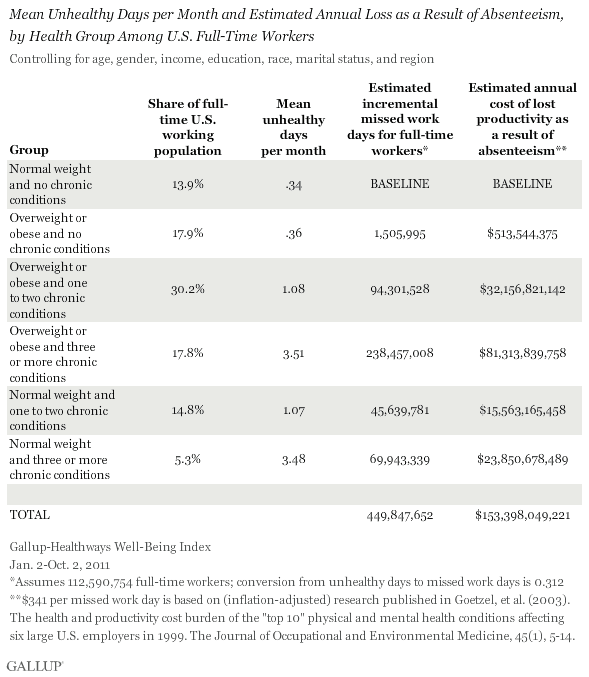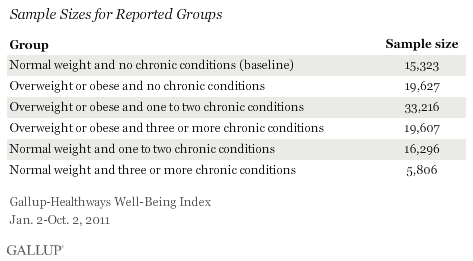WASHINGTON, D.C. -- Full-time workers in the U.S. who are overweight or obese and have other chronic health conditions miss an estimated 450 million additional days of work each year compared with healthy workers -- resulting in an estimated cost of more than $153 billion in lost productivity annually.

These findings are based on Gallup-Healthways Well-Being Index data collected between Jan. 2 and Oct. 2, 2011. Gallup surveyed 109,875 full-time employees -- those who work at least 30 hours per week -- during this time period.
The Gallup-Healthways Well-Being Index uses respondents' self-reports of their height and weight to calculate body mass index (BMI) scores. BMI values of 30 or higher are classified as "obese," 25.0 to 29.9 are "overweight," and 18.5 to 24.9 are "normal weight."
Chronic health conditions in this analysis include being overweight or obese; having ever been diagnosed with a heart attack, high blood pressure, high cholesterol, cancer, diabetes, asthma, or depression; and recurring physical pain in the neck or back or knee or leg in the last 12 months. Gallup calculated unhealthy days using respondents' answers to the question, "During the past 30 days, for about how many days did poor health keep you from doing your usual activities?"
Full-time workers who are of normal weight and do not suffer from chronic health conditions make up 13.9% of the U.S. workforce and average .34 unhealthy days each month -- or about 4 days per year. The average number of unhealthy days per month is slightly higher at .36 among those who are overweight or obese and do not have additional chronic health conditions.
Unhealthy days per month increase further to 1.08 for workers who are overweight or obese and have one to two additional chronic health conditions. Workers who are of an above-normal weight and have three or more chronic health conditions report a significantly higher average of 3.51 unhealthy days per month -- that is about 42 days per year.
To estimate how unhealthy days per month translate into missed work days, Gallup asked workers this question: "Earlier, you indicated that you had xx days in the last month where poor health prevented you from doing your usual activities. How many actual work days in the last month did you not work due to poor health?" The results indicated that one unhealthy day per month for full-time workers is equivalent to about 0.31 actual missed days of work.
See page 2 for a full description for estimating the economic cost of unhealthy days.
Implications
The $153 billion in annual lost productivity costs linked to unhealthy workers in the United States is more than four times the cost found in the United Kingdom. The striking difference is the result of fewer unhealthy workers in the U.K. About 14% of full-time U.S. workers are of a normal weight and have no chronic illness, compared with 20% in the U.K.
The high percentages of full-time U.S. workers who have less than ideal health are a significant drain on productivity for U.S. businesses. However, employees and employers have the opportunity to potentially increase productivity if they address the health issues that are currently plaguing the workplace.
The $153 billion in lost productivity estimated in this analysis would increase if it included presenteeism, which is when employees go to work but are less productive in their jobs because of poor health or well-being. Including part-time employees would also add to the estimate of costs in lost productivity. Other research that has examined a broader array of factors using a somewhat different list of chronic conditions places the economic effect of lost productivity at $1.1 trillion per year (PDF download).
About the Gallup-Healthways Well-Being Index
The Gallup-Healthways Well-Being Index tracks well-being in the U.S., U.K., and Germany and provides best-in-class solutions for a healthier world. To learn more, please visit well-beingindex.com.
Survey Methods
Results are based on telephone interviews conducted as part of the Gallup-Healthways Well-Being Index survey Jan. 2-Oct. 2, 2011, with a random sample of 270,695 adults, aged 18 and older, living in all 50 U.S. states and the District of Columbia, selected using random-digit-dial sampling. Of these, 109,875 were employed full time at the time of the interview and they provided height and weight data to calculate body mass index scores.
For results based on the total sample of national adults, one can say with 95% confidence that the maximum margin of sampling error is ±2 percentage points. For the worker health groups, the maximum margin of sampling error is between ±1.7 and ±0.6 percentage points.

Interviews are conducted with respondents on landline telephones and cellular phones, with interviews conducted in Spanish for respondents who are primarily Spanish-speaking. Each sample includes a minimum quota of 400 cell phone respondents and 600 landline respondents per 1,000 national adults, with additional minimum quotas among landline respondents by region. Landline telephone numbers are chosen at random among listed telephone numbers. Cell phone numbers are selected using random-digit-dial methods. Landline respondents are chosen at random within each household on the basis of which member had the most recent birthday.
Samples are weighted by gender, age, race, Hispanic ethnicity, education, region, adults in the household, and phone status (cell phone only/landline only/both, cell phone mostly, and having an unlisted landline number). Demographic weighting targets are based on the March 2010 Current Population Survey figures for the aged 18 and older non-institutionalized population living in U.S. telephone households. All reported margins of sampling error include the computed design effects for weighting and sample design.
In addition to sampling error, question wording and practical difficulties in conducting surveys can introduce error or bias into the findings of public opinion polls.
For more details on Gallup's polling methodology, visit www.gallup.com.
Step 1: Converted full-time workers' average number of unhealthy days per month into an annual average.
Step 2: Converted the average number of annual unhealthy days into the average number of actual missed work days each year by multiplying each value by 0.31. The 0.31 conversion factor, as noted in the article, is based on an analysis of workers' responses to this question: "Earlier, you indicated that you had xx days in the last month where poor health prevented you from doing your usual activities. How many actual work days in the last month did you not work due to poor health?"
Step 3: Multiplied the average annual number of missed work days for each group by the actual number of full-time workers in each group. Gallup calculated the number of full-time workers in each group based on 234 million U.S. adults, which was then multiplied by the percentage of adults who have a full-time job (about 48% according to Gallup).
Step 4: Calculated the number of incremental missed work days per year for each group by multiplying the total number of workers in each group by the average number of unhealthy days per year beyond the unhealthy days per year for the baseline group of workers who are of normal weight and have zero chronic health conditions.
Step 5: Calculated the total cost to U.S. employers by multiplying the missed number of work days by $341 per day.
